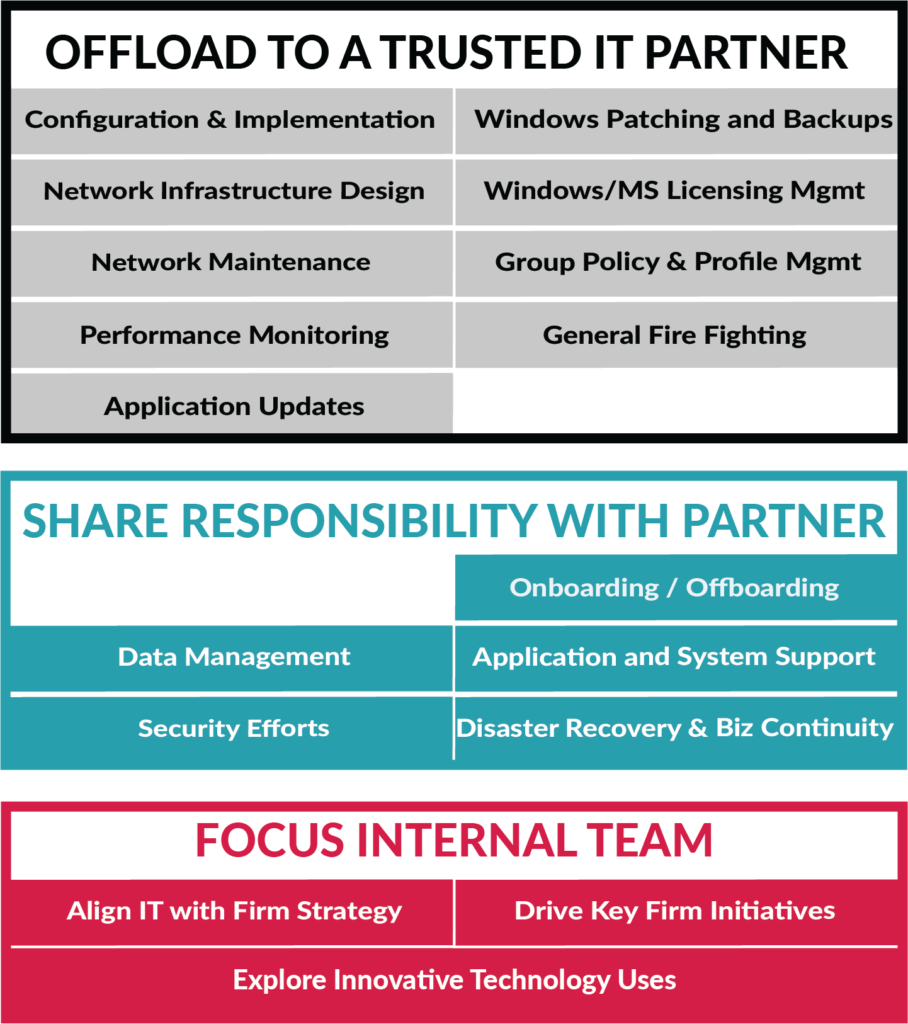In our last blog post, we highlighted the importance of making IT a partner when defining law firm strategy. In this post, we’ll talk about some of the barriers to being able to do so.
While IT has taken an increasingly more strategic role over the past decade, the demand on IT has also increased exponentially.
Consider: in the past 10 years, we’ve seen a dramatic expansion in application adoption and a rise in complexity via the use of virtual machines, remote desktops, public and private clouds, the Microsoft 365 ecosystem, and more.
In addition, organic adoption of tools and software by legal staff as well as the rise of software as a Service (SaaS) applications and the proliferation of mobile devices expands the footprint the IT and operations teams need to secure.
As more data is held online (and email addresses become the de facto key to unlock that data), cybercriminals have actively targeted law firms both for their access to sensitive client data, but also as an easier entry point to penetrate the more secure walls of firm clients.
All this is to say that even if a firm has continued to invest in IT with more resources, the demands on IT have likely still outstripped your investments.
A Bird’s Eye View into IT
Let’s look at that claim more closely. At a high level, the image below outlines the challenge IT teams face today.
In red are the critical, urgent activities that every IT team must execute against. Very few of these are strategic in nature, but they’re all necessary to “keep the lights on.” And while some may be occasional (depending on the size of the firm), many – if not most – of these responsibilities require constant, time-consuming vigilance.
Across the board, each are impacted by rising complexity, shadow IT, application adoption, and an increased threat surface. Even those that seem less urgent (disaster recovery & business continuity plans as an example) need attention as the recent COVID-driven remote work mandates recently illustrated.
In the face of a constant barrage of urgent tasks, it’s no wonder that strategic IT initiatives are frequently de-prioritized in favor of an immediate crisis or action item.
Creating IT Capacity
As law firms continue to push productivity and profitability initiatives, staff capacity is always both a concern and a focus. In actuality, strategic IT investments—when aligned with your overall firm strategy—can actually advance those goals faster than any other initiative.
Yet to be successful, in such initiatives, you need the right mix of talent. Proper execution of many of the responsibilities outlined previously depend upon a highly specialized technical skillset (e.g. cloud infrastructure and application support) that is costly to acquire or grow in-house.

What’s interesting, however, is that while such responsibilities typically require a high degree of firm familiarity, it does not require the firm intimacy that strategic initiatives do.
When we analyze that set of IT responsibilities through such a lens (i.e. what requires intimate firm knowledge vs “mere” firm familiarity), we quickly identify a rather large percentage of responsibilities that require specialized technical skillsets, but where firm intimacy is not strictly necessary.

It’s no wonder also why firms that outsource their IT are left with a tactical rather than strategic relationship—if you don’t select a true technology “partner” with deep industry expertise, you can’t get the intimate consulting partner you need.
Meanwhile, a law firm with internal IT can take advantage of cloud services and identify a partner that has the necessary cloud, networking, and application skills that will enable you to transfer ownership for up to 50% of IT responsibilities and gain meaningful support for two-thirds of what’s left.
That leaves your internal team the space to prioritize and focus on the strategic initiatives that will advance your firm’s long-term vision.
Kicking Off Your Near-Term Initiative
Of course, none of this is quite as easy as such simple charts make them seem. Turning to cloud services is itself a series of critical tasks and decisions. You need to address the reservations of firm leadership, perform a thorough cost analysis, weigh the benefits of private versus public cloud options, etc.
However (and we acknowledge our implicit bias here), most firms find that identifying the right partner early in this process can substantially reduce the time and effort to kick such an initiative off.
While helpful at reducing the burden, a tactical relationship will leave you still struggling to advance IT strategically as you get pulled back into day-to-day fire-fighting.
If you already rely on an IT partner but find that your internal capacity has not dramatically increased, you may have found yourself in a tactical relationship rather than a strategic one.
Instead, look for a consultative cloud services partner that has:
- Intimate knowledge of the challenges law firms face to help navigate internal concerns (and the references to back it up),
- Experience to transition your IT environment quickly and effectively,
- Partnerships to ensure your cloud environment is both cost-effective and robust,
- Expertise to address security, performance, reliability, and scalability, and most importantly,
- A consultative mindset to ensure you preserve current and future agility.

How are you doing things at your firm? Are you seeing the same patterns impacting your firm’s ability to make IT a strategic partner to the firm?
